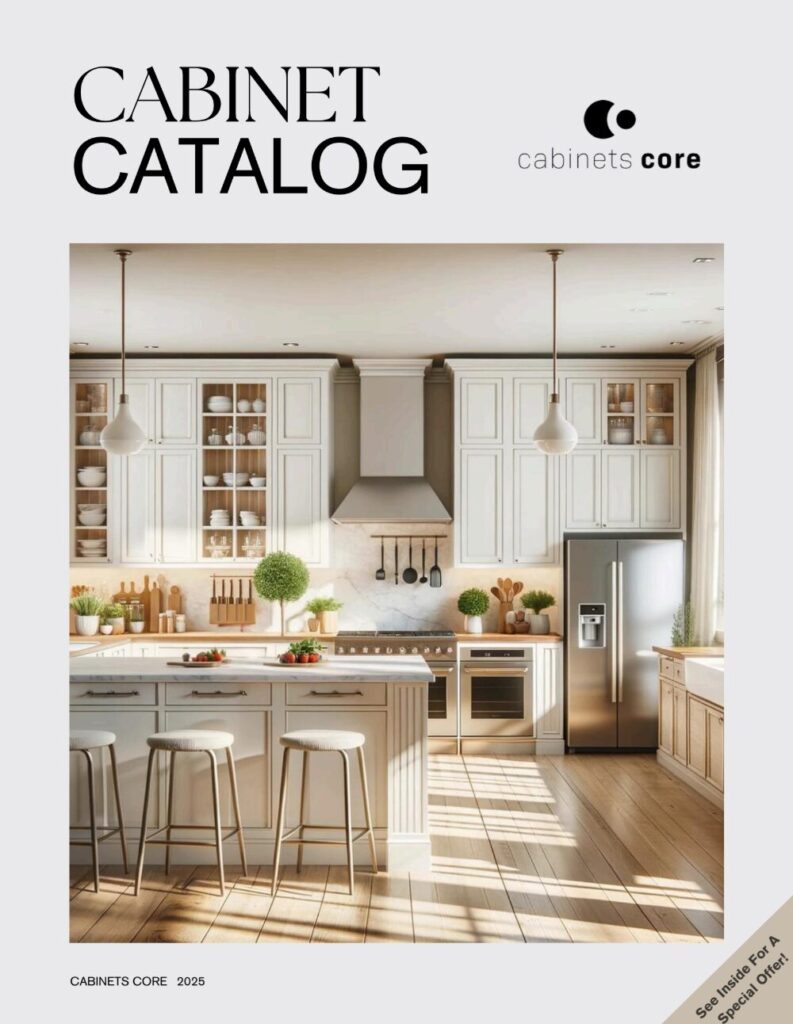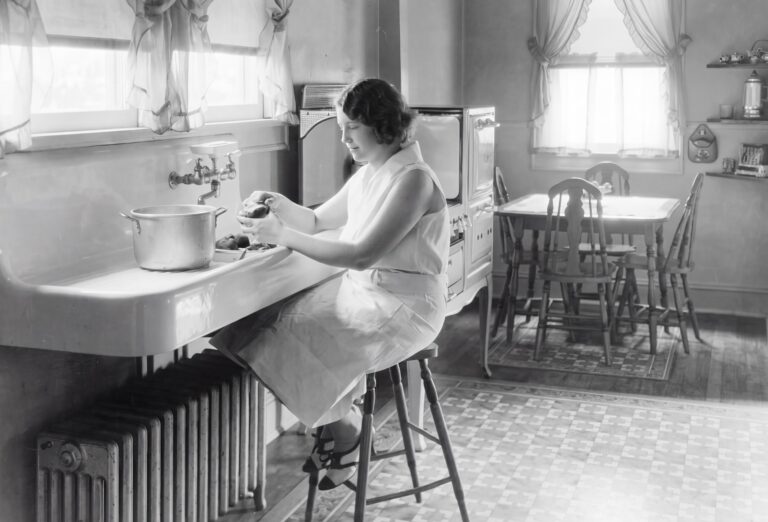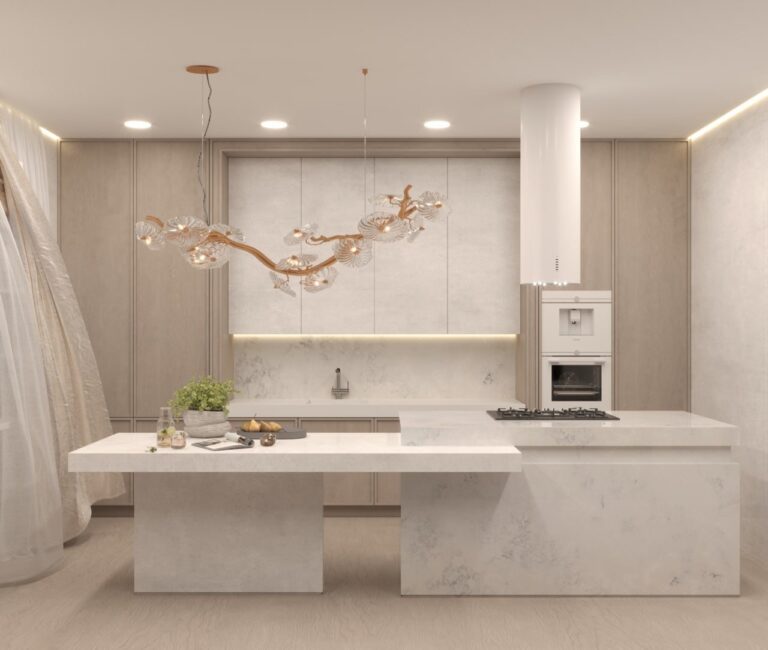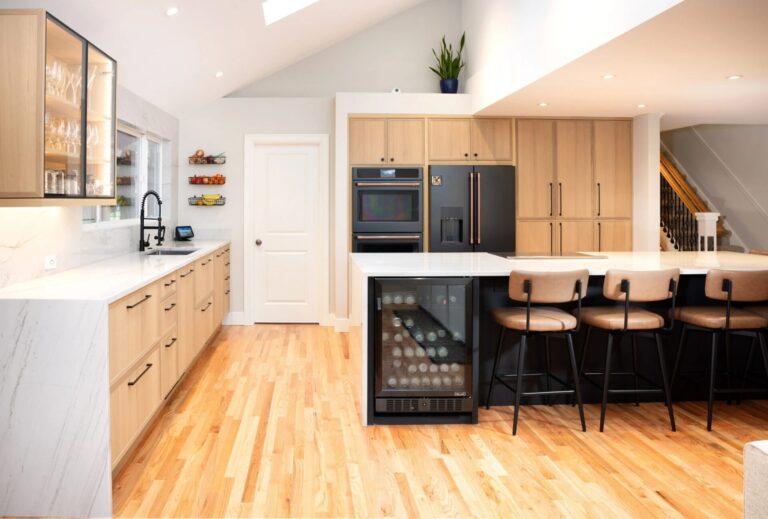If you’re planning a kitchen or bath remodel in Auburn, Kent, Renton, Federal Way, Tacoma, Bellevue, Issaquah, or anywhere in Greater Seattle, the material inside your cabinets will determine how they look, feel, wear, and age. At Cabinets Core, we build and source across all common substrates – solid wood, plywood, MDF, and particleboard – and we finish them with real-world details like edge banding, joinery, and coatings that decide whether your doors stay straight, your shelves resist sag, and your boxes survive a decade of Pacific Northwest humidity.
How cabinet boxes are actually built
Most cabinet boxes are engineered wood wrapped in a finish layer. A typical box includes sides, top, bottom, back, a toe-kick, and shelves, plus a separate front system – either a face frame for classic American style or a frameless (European) front for maximum access and modern lines. The substrate you choose affects screw-holding strength, moisture behavior, weight, and repairability. The finish layer – thermofoil, melamine, laminate, or hardwood veneer – determines the tactile surface, cleanability, and color or grain you see.
Solid wood: beauty, reparability, and movement you must respect
Solid maple, oak, cherry, walnut, or birch is prized for doors, face frames, and decorative components because it offers natural grain, crisp edges, and the ability to sand and refinish. It’s inherently strong along the grain, can be repaired after dents or scratches, and ages into a patina rather than a plastic sheen. Wood also moves with seasons; boards expand and contract across the grain. In the Pacific Northwest, where indoor humidity swings through wet winters and dry, heated interiors, solid panels used incorrectly can cup or crack. That is why solid lumber is best for stile-and-rail doors, frames, and trim, while large flat surfaces like box sides and panels are usually better in plywood or MDF to preserve flatness.
Plywood: the workhorse for strong, light, moisture-tolerant boxes
Cabinet-grade plywood is layers of veneer glued with alternating grain directions. That cross-laminated core provides high stiffness, the best screw-holding among engineered options, and good resistance to ambient moisture. It’s relatively light for its strength and it machines cleanly. In kitchens, laundry rooms, and baths, plywood boxes tolerate steam and the occasional spill far better than particleboard and typically better than standard MDF. The edge shows plys and must be finished with edge banding or a hardwood frame. Quality varies by core: veneer core offers light weight and excellent screw grab; MDF core can be flatter for ultra-smooth veneer faces but is heavier; combi cores blend attributes. We specify thicknesses intentionally—18 mm (nominal 3/4″) for sides and shelves and 12 mm (1/2″) or 6–9 mm (1/4″–3/8″) for backs depending on mounting method—so boxes stay rigid and walls stay square during installation.
MDF: the king of smooth paint and laser-clean profiles
Medium-density fiberboard is wood fibers bonded under high pressure for a dense, uniform panel. Because there’s no grain to telegraph through paint, MDF is the best substrate for flawless painted Shaker, slab, and routed designs. It won’t twist like a wide solid-wood panel, and it machines into crisp, consistent profiles. Standard MDF is heavy and will swell if water intrudes at raw edges; that’s why we seal edges and recommend moisture-resistant (MR) MDF for bath and laundry doors or for homes where daily steam is a factor. For box interiors, MDF can work when fully laminated, but we usually prefer plywood for strength-to-weight and fastener holding.
Particleboard: today’s budget choice with clear limits
Particleboard is wood chips and resin pressed into sheets. Modern, high-density boards with quality laminates can look sharp and keep weight down, which is why big-box ready-to-assemble cabinets use it. It’s the most cost-effective way to create a flat, consistent interior surface for light to moderate use. However, screw threads can strip more easily, raw edges wick moisture, and shelves of long span will sag sooner under weight. In dry, low-abuse spaces like guest baths or auxiliary storage, it can be perfectly adequate. In active Seattle-area family kitchens, laundry rooms, or rentals that see spills and hard use, we recommend stepping up to plywood boxes.
Finishes that protect the core
What you touch matters as much as what’s inside. Thermally fused melamine creates a hard, cleanable interior with modern patterns or solid colors. High-pressure laminate adds impact resistance and extensive design options. Real wood veneer gives you authentic grain that can be stained to taste while retaining engineered stability beneath. Painted finishes rely on substrate prep; MDF doors with 2K catalyzed coatings deliver the smoothest paint in our lineup, while stained or clear-coated hardwood doors highlight natural variation.
Moisture, warping, and the Pacific Northwest reality
Seattle-area homes experience moisture from two sides: wet outdoor air and indoor steam from cooking and bathing, then drier air in heated winters. Plywood tolerates these swings best for boxes. MDF doors remain flat if edges are sealed and bathrooms use MR MDF or well-finished hardwoods. Solid wood doors are stabilized by engineering—the stiles and rails float a center panel to avoid stress. Particleboard needs full coverage with no exposed raw edges, careful protection at sink bases, and diligent caulking where water might intrude.
Joinery, edge banding, and hardware: the “hidden” quality you can feel
A cabinet’s integrity depends on how parts meet. Dowel and confirmat construction suits frameless systems; pocket-screw and dado joinery shine in face-frame builds. Full-height backs in 12–18 mm material anchor to studs without racking. Real wood or ABS/PVC edge banding seals edges against humidity and impacts; thick, pre-applied banding on factory parts resists peeling far better than field-ironed tape. Soft-close, full-extension undermount slides rated 75–100 lb keep drawers smooth even when loaded with cast iron; European clip-on hinges with six-way adjustment hold door reveals dead even. These choices outlast trends and spare you service calls.
Shelves, span, and the science of sag
Shelf stiffness depends on thickness, material, and span. A 3/4″ plywood shelf will resist deflection better than the same span in particleboard. If you store heavy dinnerware or small appliances, we tighten shelf pins, reduce span with a mid-panel, or increase thickness to 1″ for long runs. It’s not overbuilding—it’s designing for how you live.
Health, certifications, and indoor air quality
We prioritize low-emission panels that meet or exceed CARB Phase 2 and TSCA Title VI formaldehyde limits. Waterborne and catalyzed finishes we use are selected for durability with minimized VOC impact during finishing and in your home. If you’re chemically sensitive, tell us early; we can spec ultra-low-emitting substrates and finish systems accordingly.
Where each material makes the most sense
In a high-use kitchen with kids, pets, and daily cooking, plywood boxes with either hardwood or MDF doors deliver the best durability-to-cost ratio. In a primary bath with regular steam, plywood boxes with MR-MDF or hardwood doors and sealed edges maintain stability. In a mudroom or laundry, plywood boxes and either laminate-faced slab fronts or painted MDF doors take scuffs and clean up easily. In guest baths, offices, and auxiliary storage, high-density particleboard interiors with quality laminates can stretch the budget without sacrificing everyday function. For heirloom looks or period homes, solid wood frames and doors layered over plywood boxes give you authenticity without inviting seasonal warp.
Costs, value, and total ownership
Upfront, particleboard is least expensive, MDF and entry plywood cluster in the middle, and furniture-grade plywood and hardwoods sit at the high end. Over a 10–20 year horizon, plywood’s lower failure and service rates often make it the most economical choice, particularly under sinks, dishwashers, and in rooms with fluctuating humidity. Painted MDF doors cost more than thermofoil or melamine but give you the premium, repairable look homeowners expect in high-end remodels. Solid wood doors and frames cost more again but can be refinished and repaired repeatedly, extending lifespan.
Face frame vs. frameless: space, style, and hardware access
Face-frame cabinets present a classic American aesthetic with visible rails and stiles; they’re forgiving on uneven walls and pair well with inset and partial-overlay doors. Frameless cabinets maximize interior width, drawer size, and contemporary styling; they rely on precise machining and higher-grade hardware to keep reveals perfect. Either system can be executed in plywood, MDF, or particleboard cores; quality is in the execution.
Common myths, quickly clarified
“Solid wood is always best.” Solid is best for doors and frames but can misbehave in large panels; engineered cores exist to stay flat. “Particleboard is trash.” High-density panels with full lamination can serve for light-to-moderate duty, especially away from water. “MDF swells no matter what.” Raw MDF edges will swell if soaked; sealed edges and MR grades in appropriate rooms perform very well. “Plywood is waterproof.” It’s moisture resistant, not waterproof; standing water will still cause damage, so protection at sink bases matters.
How Cabinets Core builds for Greater Seattle conditions
We default to cabinet-grade plywood boxes for kitchens and baths unless your project calls for a specific alternative. We seal sink bases, specify full backs for rigidity, and edge band all exposed edges. We pair boxes with your choice of hardwood or MR-MDF doors depending on finish and style, then hang everything on soft-close, lifetime-warranty hardware rated for real loads. For budget-focused rooms or ancillary storage, we’ll design a hybrid that saves where use is light and invests where failure would hurt. Every plan includes free in-home measurement and a 3D design so you can see spans, interior capacity, and door reveals before we build.
Maintenance and lifespan
Well-built plywood boxes with quality hardware routinely last 20 years or more with only hinge and slide adjustments as doors settle and homes move. Painted MDF doors may eventually show corner wear at high-traffic pulls; a light refinish revives them. Hardwood doors can be touched up, re-stained, or refinished. Particleboard interiors appreciate gentle cleaning and vigilance around leaks; catching drips early extends their life substantially.
Straight answers to the questions we hear most
Is plywood better than MDF in kitchens with daily use and occasional steam? Yes, for boxes it generally is, thanks to better screw holding and moisture tolerance. MDF remains the first choice for the smoothest painted doors.
Do solid wood cabinets last longer than engineered options? Properly constructed, a plywood box with hardwood or MDF doors will match or exceed the practical lifespan of all-wood boxes because engineered panels stay flatter and hardware stays aligned. Solid wood excels in reparability and authentic grain, so it often wins for doors and frames.
Are particleboard cabinets always a mistake? No. In guest baths, offices, or rental refreshes with disciplined water protection, laminated particleboard can be a smart cost play. For busy family kitchens and sink bases, invest in plywood.
Can you mix materials in one kitchen without it looking cheap? Absolutely. Many of our best projects use plywood boxes for structure, MDF for painted doors, and solid wood for accents like panels, floating shelves, or an island. The key is consistent finish quality and thoughtful transitions.
What’s best for humid bathrooms? Plywood boxes, MR-MDF or hardwood doors, and meticulously sealed edges, combined with a fan you’ll actually use. That combination keeps panels flat and joints tight.
Ready to choose the right build for your home?
If you want cabinets that look beautiful on day one and still feel tight and aligned in year ten, the substrate and how it’s put together matter. Visit the Cabinets Core showroom in Auburn to handle door samples, see plywood vs. MDF vs. particleboard boxes cut open for comparison, and review hardware options that match how you cook and live. We serve Auburn, Kent, Renton, Federal Way, Tacoma, Seattle, Bellevue, Issaquah, and the surrounding area with free measurement and a 3D design so you can decide with confidence.
Tell us how you use your kitchen and bath. We’ll engineer the right mix of materials and finishes for your space, your budget, and the Pacific Northwest climate – and we’ll stand behind it.





